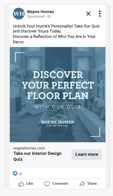
Not long ago, a builder based in Louisiana came to us with a problem common to many small-to-midsized builders. Despite running digital ads targeting home buyers, their ads weren’t showing up when potential buyers searched for basic terms like “new homes in South Bossier, LA.” The builder knew they were losing valuable leads to the competition and wanted us to figure out why.
We found the problem wasn’t visibility in general but rather the lack of hyper-local optimization and precise audience targeting (I know - that’s a mouthful). As a mid-sized builder, they were competing against industry giants like Zillow, Realtor.com, and D.R. Horton—large companies that dominate search results by focusing on highly strategic locations and audiences.
Once we helped this builder fine-tune their digital strategy, the traffic and leads started pouring in.
What Is Hyper-Local Optimization and Precise Audience Targeting?
Hyper-local optimization focuses your digital ads on specific geographic areas, narrowing the scope to locations that matter most to your target audience. For example, instead of targeting “Bossier City,” you focus on “South Bossier,” a smaller but more relevant area where home buyers are actively searching.
Precise audience targeting, on the other hand, zeroes in on key behaviors, demographics, and life events of potential buyers. Think about targeting a new family looking to move up in home size, or retirees looking to downsize. And when you combine both hyper-local optimization and precise audience targeting, you don’t just reach more people—you reach the right people at the right time.
Success Stories: Real Results from Hyper-Localization and Audience Targeting
Let’s look at two real examples of how these strategies transformed our clients’ marketing performance:
 Holt Homes (US Pacific Northwest)
Holt Homes (US Pacific Northwest)
Prior to 2022, Holt Homes ran PPC (pay-per-click) campaigns based on what they thought were solid keywords. Only problem was, they had minimal geographic and audience targeting, and weren’t getting a very good ROI on the digital spend. After implementing hyper-local optimization and precise audience targeting, they saw a 51.77% increase in impressions, a 70.98% increase in clicks, and an incredible 73.54% increase in leads.
 Flintrock Builders (Texas)
Flintrock Builders (Texas)
Flintrock had a similar situation with their underperforming paid search spend. Comparing May to August 2023 (pre-strategy) with September to December 2023 (post-strategy), Flintrock Builders achieved an 88.90% increase in impressions, 81.30% more clicks, and a 43.14% increase in leads.
These are just a couple of examples that demonstrate how hyper-local optimization and precise audience targeting can make a significant difference in home builder marketing, helping builders stand out against larger competitors.
Key Components of Hyper-Local Optimization & Audience Targeting in Media Ads
Here are the fundamental components that help maximize your marketing strategy through hyper-local optimization and audience targeting:
Local SEO
It's important to use local keywords in your ad copy because it helps enhance your visibility in specific geographic areas. It also ensures that your advertising messages are consistent and align with what buyers are searching for. Utilizing platforms like Google Business Profile (formerly Google My Business) and incorporating area/location pages on your website (here's an example) allows you to optimize for local search terms that capture high-intent buyers.
A long time builder client with Bokka, Wayne Homes has seen a huge success in the implementation of local SEO via geo keyword focused landing pages. Between June and July 2024, organic traffic saw a 16% increase directly related to the inclusion of SEO focused landing pages.
Geotargeting
Don’t just target cities like “Bossier City”; narrow it down to specific neighborhoods or areas where your ideal buyers live or where your competitors are located. You can even target highly trafficked locations where potential buyers are likely to be.
Demographic Targeting
Tailor your ads to fit the key demographics of potential home buyers. Whether you’re targeting young families looking for a first home or retirees seeking to downsize, demographic information such as age, income level, and family status helps you reach the right people.
Behavioral Targeting
Targeting specific behaviors or events—like a family expanding or a couple nearing retirement—helps ensure your ads reach buyers at the right point in their life. Even online behaviors, such as searching for “new homes in South Bossier,” are critical factors to consider.
Custom Audiences
Use custom audiences to reach potential buyers who have already visited your website or who share similar traits with your current buyers. By targeting these specific groups, you can expand your reach while maintaining a high conversion rate.
Paid Social Advertising
Paid social advertising is another powerful tool for home builders looking to target specific audiences. Platforms like Facebook, Instagram, and LinkedIn allow you to tailor your ads based on demographics, interests, and behaviors, reaching potential buyers who may not yet be actively searching for homes. By combining paid social with custom audiences, you can create highly relevant ads that appear in front of the right people, amplifying your reach and increasing engagement with prospective buyers.
Social Proof: Audience Targeting With a Personality Quiz
Wayne Homes' "Perfect Floorplan Quiz" combined paid social with custom audiences and boosted their impression-to-visit rate from 0.74% up to 2.02% - a whopping 173% increase.
And the quiz itself is a lead magnet - one of their highest converting pages.
How a Colorado Builder Crushed Their Model Grand Opening
 We work with many builders on Model Grand Openings to build awareness, leads, and presales in new communities. With Colorado-based Boulder Creek Neighborhoods, we used a geo-targeted landing page and inbound media strategy to target the right audience in the right locations.
We work with many builders on Model Grand Openings to build awareness, leads, and presales in new communities. With Colorado-based Boulder Creek Neighborhoods, we used a geo-targeted landing page and inbound media strategy to target the right audience in the right locations.
The results were impressive:
- A 41% increase in pageviews from previous events
- A 16% increase in users from targeted inbound media
- A 33% increase in event attendance, with 200 qualified prospects attending the Model Grand Opening.
This approach not only increased awareness of the community but also drove qualified prospects to their event, proving the power of combining hyper-local optimization with precise audience targeting.
Read more about this builder's grand opening success story here.
Strategies for Implementing Hyper-Local Optimization and Audience Targeting
Now that you understand the “why,” here’s the “how.” Implementing a hyper-focused, targeted campaign involves several key strategies:
Identify Target Areas
The first step is identifying the geographic areas that are most relevant to your buyer personas. Dive into Google Analytics (GA4) to track where most of your traffic comes from and what those visitors are doing on your site. Use this data to identify local areas to focus on.
Audience Targeting Along the Funnel
Different types of ads are more effective at different stages of the buyer’s journey. For example, use display ads to raise awareness at the top of the funnel and search ads for those further down the funnel with high buying intent.
Local SEO & Keyword Research
Use tools like SEMrush and Google Keyword Planner to identify which search terms homebuyers are using. By optimizing for the right terms, you can improve your ad targeting.
When we applied these strategies for BCN’s Model Grand Opening, they saw a 50% increase in landing page visits and 33% higher event attendance compared to previous events.
Measuring the Success of Hyper-Local Campaigns
 Once your campaign is up and running, it’s important to measure success. Here are a few key performance indicators (KPIs) we recommend tracking:
Once your campaign is up and running, it’s important to measure success. Here are a few key performance indicators (KPIs) we recommend tracking:
Lead Generation
Are your leads increasing, and are they of higher quality? Do the conversion rates meet or exceed builder-industry standards? Focus not only on the quantity but also the quality of leads.
Engagement
Are visitors spending more time on your site, reading blogs, or interacting with your ads? Engagement metrics help you gauge whether your content resonates with your audience.
Website Traffic
Is there a significant increase in traffic from the geographic areas you’re targeting? Are users spending more time on the site or visiting key landing pages?
By continuously measuring and analyzing your campaign’s performance, you’ll be able to make informed decisions and optimize for better results.
Don’t Just Assume Your Digital Campaigns are Performing Well
New home builders have a lot to gain from using hyper-local optimization and precise audience targeting to boost their digital campaigns. By focusing on specific geographic areas and tailoring your content to the unique needs of your target audience, you’ll be sure your marketing campaigns reach the right people at the right time.
If you’re unsure where to start or need help optimizing your campaigns, reach out to us at Bokka. We’re here to help refine your digital strategy and increase your ROI.


.png)